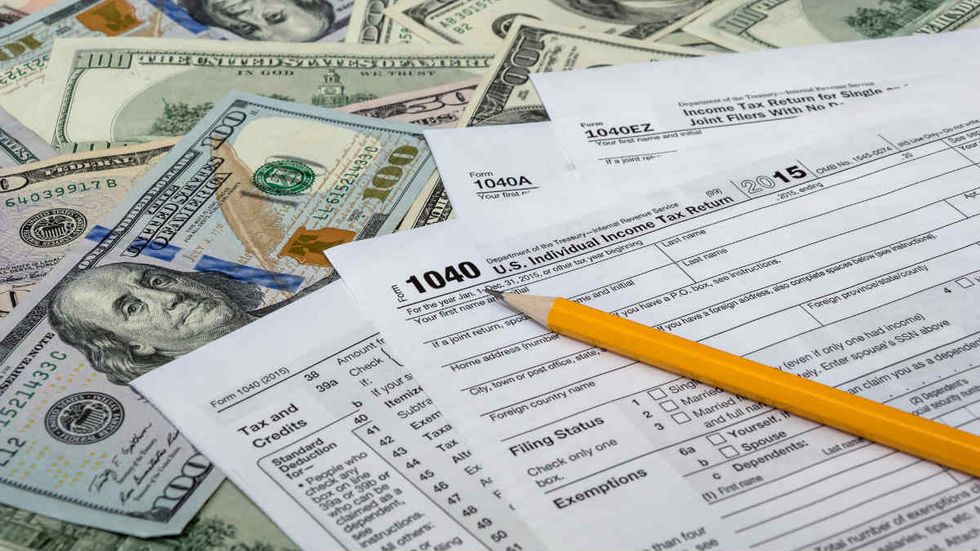
© 2024 Blaze Media LLC. All rights reserved.
The GOP tax plan has been plagued by the same problem throughout the truncated and rushed process: a lack of vision. The lack of vision stems from the fact that both parties refuse to cut spending and are therefore limited by revenue constraints in their ability to forge a deliberate tax cut without having to balance random bad provisions against each other. The result has been a lack of uniform outcomes for individuals and businesses, random winners and losers simply based on the desire to meet certain revenue scores, and a wide perception from the public that they will not even get a tax cut.
While the Senate bill employed many scoring gimmicks to fix some of the problems with the House individual tax plan, there are still some problems on the individual side. Moreover, to “pay” for the extra cuts to the individual code, they muddled the corporate tax cut and made it less pro-growth. Besides, the GOP messaging on the bill has already made it so unpopular that even those who get a substantial cut don’t realize it.
It is quite evident that the only solution for the GOP is to cut spending by at least a half-trillion over 10 years and use that revenue to make the tax cuts better and plug any gaps. Citizens Against Government Waste has identified $644 billion in spending cuts over just one year, adding up to well over $5 trillion over 10 years. By merely adopting one-tenth of the group’s recommendations, primarily dealing with waste, fraud, and corporate welfare, Congress can make this tax plan way better.
Here are the key issues that should be addressed in conference:
1. Eliminate bracket creep: The House and Senate tax bills adopt a more modest formula to calculate the growth of inflation as it relates to tax brackets, known as “chained CPI.” Over time, this will place more people in higher tax brackets even though their earning power will not grow as quickly. Although the rate cuts in the final Senate bill are steep enough to ensure that most get a tax cut even with chained CPI, in the long run it will erase much of the tax cut and even result in a tax increase for some if this is not changed down the road. This provision brings in $134 billion of revenue and should be eliminated and offset with spending cuts.
2. Add personal exemption for those without dependent children: This bill is heavily weighted towards those who have dependent children. While most people on both sides of the tax debate agree families with children should get a bigger tax cut, this bill is so weighted against those who don’t have children or who are empty-nesters that for many in the latter category, they will only get a small tax cut. And for a married couple who own a home, with grown-up children, living in a high tax jurisdiction, the loss of itemized deductions might not be fully offset by the rate cuts. Worse, the axed personal exemption grows with inflation, while the rate cuts are blunted by the chained CPI, as noted above, meaning the tradeoff will grow more and more imbalanced over time.
For those who are earning a substantial amount, the rate cuts, in conjunction with the elimination of much of the AMT, will clearly be worth the loss of the personal exemption. Also, for those who don’t itemize their deductions because they live in a low local tax jurisdiction, have little or no mortgage interest left, or both, they will clearly come out ahead because the standard deduction is now doubled. Most young couples without children do not own homes and are therefore not itemizing their deductions now anyway. The problem is for an empty-nester couple earning roughly $80,000-$150,000 with a mortgage and a state and local income tax burden that places their itemized deductions above even the doubled standard deduction ($24,000) under the new proposal. The lowered rates will not bring down their tax liability enough to offset the loss of itemization and the loss of the personal exemption.
Rather than completely abolishing the personal exemption, the conference should add in an option to either take the expanded child tax credit or receive a partial personal exemption. Obviously, all families or individuals without dependents would then take the option for the personal exemption. Under current law, the personal exemption is $4,050 per person. Rather than eliminating it altogether, they should keep a roughly $1,500-$2,000 personal exemption per person for those not eligible for or not choosing the child tax credit. At the 22 percent bracket, such a plan would let empty-nester couples keep an extra $660-$880 of their income that would ensure everyone comes out ahead and almost everyone has a meaningful cut.
3. Change cap on state and local income tax deduction (SALT): As I’ve noted before, the compromise on SALT is the worst of all worlds. It retains a lavish $10,000 deduction from property taxes, which continues to subsidize insane property tax jurisdictions (or states like Florida and Texas that have no income tax but high property taxes), but allows zero deduction for the more universal state and local income tax. A better, fairer, and more uniform system would be to allow any income or property tax to be used for the $10,000 cap. This will likely cost another $100-$200 billion in revenue, but it would further ensure that that those with above average (but not exorbitant) local taxes do not wind up with a tax increase.
Alternatively, a better idea on SALT that would be revenue-neutral is to retain the deduction in full, but then cut the amount given in grant funds to states that have above-average taxes. Every year, the federal government gives about $700 billion to the states for all sorts of projects. The feds could cut the dollar amount of the grants for every dollar of revenue lost through SALT that is above the national average or some other benchmark. This would directly punish the state as a whole, but not individual families on their tax returns, and it would incentivize states to lower their taxes.
4. Abolish Corporate AMT: In order to make the tax cut for individuals and pass-through businesses more substantial, the Senate adopted an eleventh-hour amendment that reinstated the corporate AMT. This will limit the ability of corporations to take the R&D credit, as well as some other important cuts, and will blunt the economic growth from the overall reduction of the marginal tax rate from 35 percent to 20 percent because the cut to the effective tax rate is now minimal. It is still worth having a cut even with the AMT, but what is the point of expending such political capital when the growth will be muted?
5. Eliminate individual AMT: Every early version of this bill completely repealed the hated AMT, but the final version added in a modified version in order to “pay for” other tax cuts. Because it increased the exemption from the AMT by 40 percent, the number of people affected by the AMT would still go down by 55 percent, but most people earning between $400,000 and $700,000 would pay AMT under the final version of the bill. To be fair, for many of them, the rate cut would make it worthwhile, and many more will have the ability to convert their income to S corporations and benefit from the substantial cut to pass-through income, thereby avoiding the AMT. But for those who are still W-2 wage earners at that level, they could pay more. We don’t want to raise taxes on people who already pay an enormous amount in taxes.
6. Scrap inflation tax on sale of long-term investments: The new bill imposes a pernicious regulation on individuals (not mutual fund managers) selling stocks, requiring them to sell their oldest-purchased shares before selling the new ones. This will allow the feds to squeeze out more capital gains tax revenue. This is known as first-in, first-out (FIFO) accounting. As Larry Kudlow and Steve Moore explain, because capital gains taxes do not factor inflation into the capital gain, “many sales of long-held stock, as much as half of the reported and taxable ‘gain’ is due to the compounding effect of inflation. The actual capital gains tax paid could more than double for many stock and asset sales.” This provision only brings in a few billion of extra revenue but is very disruptive for individual investors and will distort the way people invest based on solely on government greed for extra revenue. This provision should be axed.
7. Increased tax on venture capital: The new bill requires that venture capitalists and private equity firms hold investments for three years or risk being taxed as regular income instead of capital gains. This provision should be eliminated, because it is a needless market disruption that will negatively affect risk-takers and the biggest entrepreneurs, particularly those in real estate.
These are suggestions that a thoughtful panel of conferees would ponder if they are both serious about reform but still committed to the current failed tax system. However, all of these complexities further underscore the case for true tax reform — devolving the details of taxation to the states.
Want to keep up with what's going on in Washington without the liberal media slant, establishment spin, and politician-ese?
Sign up to get CRTV’s Capitol Hill Brief in your inbox every evening! It’s free!
Want to leave a tip?
We answer to you. Help keep our content free of advertisers and big tech censorship by leaving a tip today.
Want to join the conversation?
Already a subscriber?
Blaze Podcast Host
Daniel Horowitz is the host of “Conservative Review with Daniel Horowitz” and a senior editor for Blaze News.
RMConservative
more stories
Sign up for the Blaze newsletter
By signing up, you agree to our Privacy Policy and Terms of Use, and agree to receive content that may sometimes include advertisements. You may opt out at any time.
© 2024 Blaze Media LLC. All rights reserved.
Get the stories that matter most delivered directly to your inbox.
By signing up, you agree to our Privacy Policy and Terms of Use, and agree to receive content that may sometimes include advertisements. You may opt out at any time.



